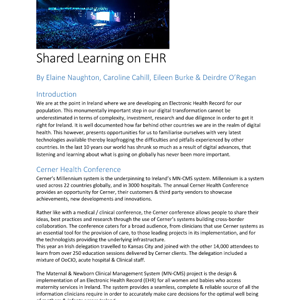Shared Learning on EHR
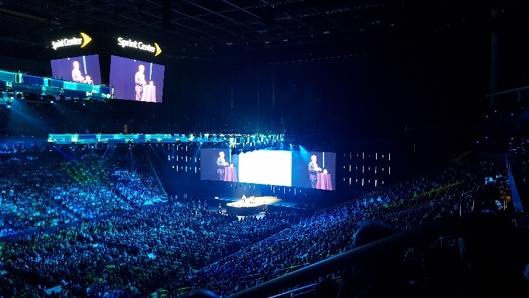
By Elaine Naughton, Caroline Cahill, Eileen Burke & Deirdre O’Regan
Introduction
We are at the point in Ireland where we are developing an Electronic Health Record for our population. This monumentally important step in our digital transformation cannot be underestimated in terms of complexity, investment, research and due diligence in order to get it right for Ireland. It is well documented how far behind other countries we are in the realm of digital health. This however, presents opportunities for us to familiarise ourselves with very latest technologies available thereby leapfrogging the difficulties and pitfalls experienced by other countries. In the last 10 years our world has shrunk so much as a result of digital advances, that listening and learning about what is going on globally has never been more important.
Cerner Health Conference
Cerner’s Millennium system is the underpinning to Ireland’s MN-CMS system. Millennium is a system used across 22 countries globally, and in 3000 hospitals. The annual Cerner Health Conference provides an opportunity for Cerner, their customers & third party vendors to showcase achievements, new developments and innovations.
Rather like with a medical / clinical conference, the Cerner conference allows people to share their ideas, best practices and research through the use of Cerner’s systems building cross-border collaboration. The conference caters for a broad audience, from clinicians that use Cerner systems as an essential tool for the provision of care, to those leading projects in its implementation, and for the technologists providing the underlying infrastructure.
This year an Irish delegation travelled to Kansas City and joined with the other 14,000 attendees to learn from over 250 education sessions delivered by Cerner clients. The delegation included a mixture of OoCIO, acute hospital & Clinical staff.
The Maternal & Newborn Clinical Management System (MN-CMS) project is the design & implementation of an Electronic Health Record (EHR) for all women and babies who access maternity services in Ireland. The system provides a seamless, complete & reliable source of all the information clinicians require in order to accurately make care decisions for the optimal well being of mothers & infants across Ireland.
Implementation of the MN-CMS system is well underway. MN-CMS went live in Cork University Maternity Hospital on 03/12/16 and in University Hospital Kerry on 11/03/17. It will go live in the Rotunda Hospital in on November 18th 2017 and the National Maternity Hospital on January 13th 2018.
Subsequent rollouts will see the MN-CMS system implemented in all Maternity Hospital/Units in Ireland
Following the successful implementation of the MN-CMS system in Cork University Maternity Hospital & University Hospital Kerry, the Irish delegation had been invited to present and two of the education sessions were delivered by clinicians from the MN-CMS Programme.
Day 1 – Saturday 7th October – Introductions
As the delegation arrived in Kansas on Saturday evening, we met to figure out our itinerary for the 4 days ahead. Our hosts, from Cerner Ireland had planned everything down to the last hour and it became abundantly clear that we had a busy few days ahead!
Day 2 – Sunday 8th October – The Precursor

On Sunday (and Monday) a separate clinical “pre-conference” event took place which was attended by the clinicians in our group.
In glorious sunshine our bus picked us up at 9am to transport us to the new Cerner campus “Innovations” along with all of the other non-US delegates (known as Global delegates).
Along the way we passed the Sprint Centre (above) where the Opening address would be held the following afternoon.
Emil Peters, President of Cerner Global, opened the proceedings by calling out the international projects that he was most proud of this year. First one to be mentioned was Ireland’s MN-CMS project which went live in Cork University Maternity Hospital in December 2016 and University Hospital Kerry in March 2017! What wonderful recognition to get.
HealtheIntent
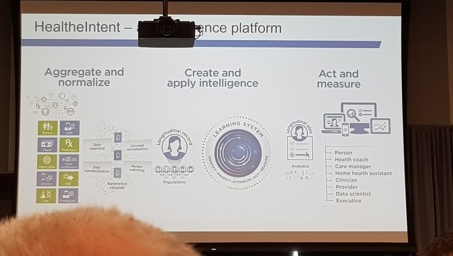
The next presentations were around Health-e-Intent, which is Cerner’s Population Health Management solution. HealtheDataLab in which open data sets from a multitude of different sources and provides the ability to perform detailed analytical investigations which can in turn empower healthcare organisations to make strategic data-driven interventions.
https://issuu.com/cerneruk/docs/pop_health_management
There were a number of different speakers, including Royal Free NHS Trust and Intermountain Healthcare. They spoke about “Clinical Practise Groups” made up of permanent multi-professional teams that oversee clinical strategy. The groups are clinically led in driving the redesign of care. They had started digitising their workflows into Millennium and plan on having 20 such workflows digitised by next year. They had found that while different hospitals had different workflows for the same scenarios, that “common things present commonly” and that had helped them reach a standard.
SMART and FHIR
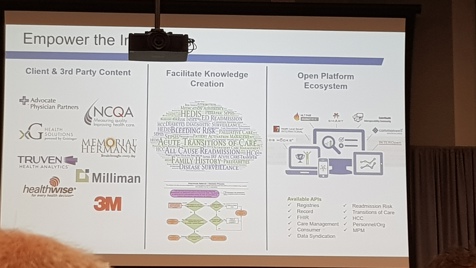
Smart and FHIR are industry standards being defined by a collaboration of clinical system providers with a goal of open interoperation between systems. Cerner are promoting Smart on FHIR to facilitate build and innovation
Patient Journey
Following this, we were shown a demonstration of CPM App development which are being developed for care pathways in Primary & social care. The presentation given by Aiden Malone, a UK-based Cerner Solution expert, was centred around different patient journeys and the way their care could be managed digitally and automatically using different products to manage their conditions outside of an acute setting in a way that worked best for their particular needs and lifestyles.
The potential and possibilities that using an Open platform solution like HealtheIntent can give to a public healthcare organisation are significant and very exciting. The frequently used example is with Diabetic patients and the ability to proactively manage patients via the App on their phone. Another example was where information on air quality in a city was used to send a text message to parents of children with respiratory conditions on days where the outside air quality was poor (e.g. High Pollen count, pollution etc). This meant that they could take appropriate preventative measures for their child. Statistics were shown that demonstrated a reduction in the number of ED admissions compared to previous occasions. These are the things that true population health management can bring about. Reduced acute episodes, and reduced hospital admissions because chronic conditions are managed at home.
Design Thinking
The concept of ‘build it and they will come’ and its ability to transcend physical structures, can be quite fascinating, and there were examples to be found throughout the Cerner Health Conference. The tour of the ‘Innovations’ campus, an all-encompassing facility, used design thinking principles in it architecture and interior design, in the hope that it would attract the most talented developers and s/w engineers, it gave us all serious office envy!

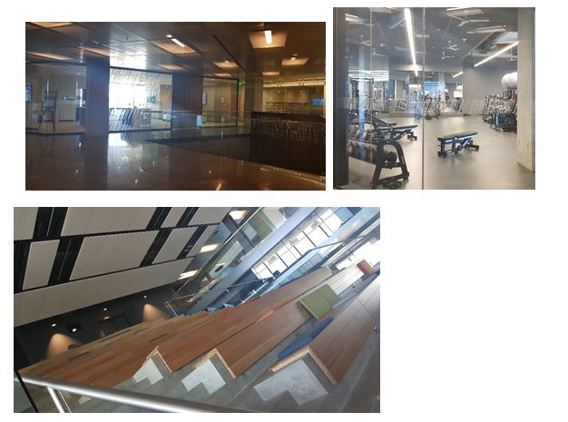
Finally, we took part in some round table discussions on the following topics hosted by the Cerner Global VP in charge of each sector:
- SMART on FHIR
- User Experience and the use of design thinking to build the product around the end user
- Data and Information Governance
- CyberSecurity
Getting the opportunity to speak directly to the most senior people in Cerner was a fantastic way to discuss both the impacts of these topics on, and potential for, the Irish health system in particular and a great way to end the day at Innovations.
Day 3: Monday 9th October - The Kickoff
Another 9am pick up to drive those of us involved in the roll-out of MN-CMS to the Cerner campus where the team of Cerner associates that we deal with daily are based. It was great to finally meet the team face-to-face and get a tour of their offices, and discuss the latest progress on the imminent roll out of MN-CMS to The Rotunda Hospital and National Maternity Hospital.

What a great way to highlight the success of your product set and underline the role your employees play in that success - all in one infographic!
At 1pm we had a scheduled tour to the Cerner data centre, a high security location that houses 47% of all US health data. Seeing how this data centre was built, managed and secured, and the level of resilience that has been built-in to every aspect of its operation was truly impressive. They have had just 3 seconds of “downtime” over the past 10 years. We also met the IRC (Immediate Response Centre) team, who are housed within the data centre.
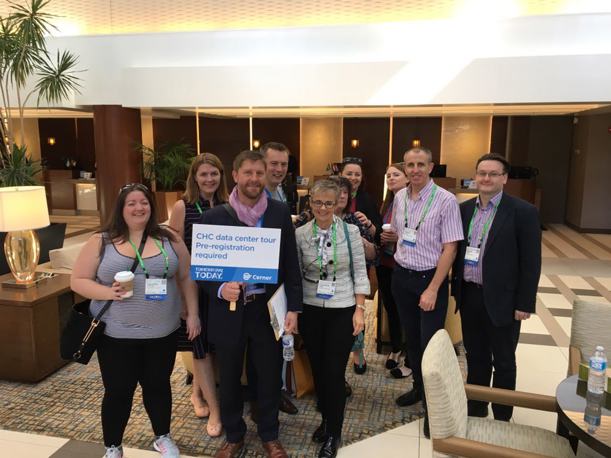
From here we went straight to the Sprint Centre for the Opening session and Keynote address at 4pm.
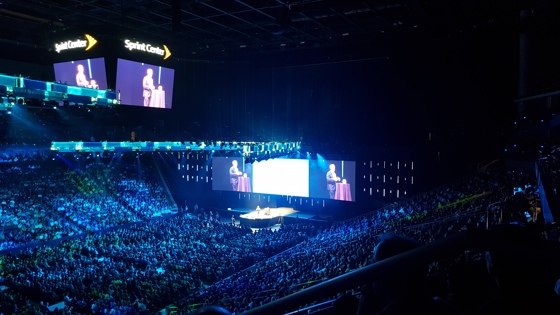
The centre was packed with 14,000 delegates from all over the US and the rest of the world. The theme was “Creating tomorrow, today”. It started with a tribute to honour Neal Patterson the organisations founder who passed away recently and each speaker spoke about the impact Neal had had on their hospital and their lives and the future plans to continue to work towards his visions.
We heard from the following :
- Kurt Newman MD and CEO of Children’s National
- David Bradshaw, CSO & CIO of Memorial Hermann Healthcare –
- Mark Briesacher, MD and President of Intermountain Medical Group
- Dick Flanigan, Cerner
- Joanne Burns, Cerner
- Donald Trigg, Cerner
- Jeff Townsend, Cerner
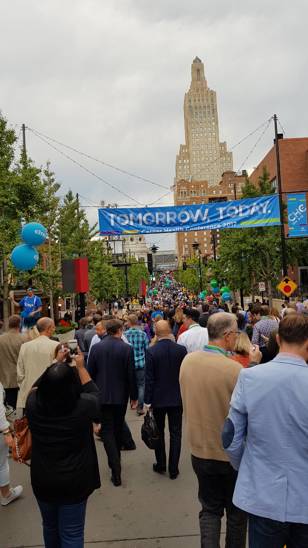
Following these speakers, at 8pm, we adjourned to Kansas City Convention Centre, the location for the main event. Here we visited the Solutions Gallery, where hundreds of suppliers had booths set up showing how they interoperate with the Cerner solution set.
One of the suppliers were Imprivata who provide a single-sign-on solution, and talked about how it might work for us in the HSE to improve user experience and patient safety.
Day 4 - Tuesday 10th October – The Main Event
With over 250 educational sessions to choose from, we were spoiled for choice. Splitting up into our own areas of interest each attended governance, infrastructure, cybersecurity and clinical sessions respectively.
Themes:
Cybersecurity
“Cybersecurity: advancing talent and intelligence through public and private collaboration”. This was hosted by Don Kleoppel ,CSO, Cerner and had a panel of speakers, who were:
- Russell Branzell, President and CEO of CHIME;
- Joanne Sexton, Cyber Institute Director, Georgia Cyber Innovation and Training Centre;
- Scott Breece, VP of Security and CISO, Community Health Systems;
- Gerry Lewis, SVP and CIO, Ascension Health, CEO, Ascension Information Services
They spoke about the importance of developing aligned cybersecurity, and how it’s not a technical issue, it’s an organisational issue. They spoke about recent attacks, including Petya and WannaCry. They spoke about developing “CyberRanges”, much like a firing range, is a simulated environment for hacking and practicing cybersecurity. They discussed the role of CISO, the Chief Information Security Officer and the importance of this role.
They spoke about the 2014 attack on CHS, where 4.5 million records were stolen in a cyber-attack and the impacts this had on the organisation. They spoke about the importance of training, development and recruitment of the right people to protect organisations against these attacks. Joanne Sexton has built the Cyber Innovation and training centre in Georgia specifically for this purpose. There is a shortage of cyber security professionals and if we are to combat this $1Trillion criminal activity, education is key.
Biomedical devices were discussed since many today are IoT enabled and so are on the network and usually un-secured, there is huge exposure with the majority of healthcare organisations.
The three main takeaways were:
1) Cyber Security is not a technology problem – it is a people and processes problem
2) Collaboration is key
3) New and innovative methods of recruiting and keeping cyber security specialists is needed
“Seven days: clinical impact of downtime from major cyber attack in Queensland”, hosted by Dr. Gordon Laurie, MD Princess Alexandria Hospital in Queensland Australia.
In May 2017, the Queensland state-wide single domain experienced reduced user access due to increased cyber security measures installed following a worldwide cyber security attack (WannaCry). This talk outlined the clinical impact of this downtime across multiple sites but focuses on the largest, the Princess Alexandra Hospital. He outlined the strategies used during the initial downtime and the subsequent recovery efforts, including adapting the business continuity plan during a long and unscheduled downtime.
Post Incident Considerations:
- General Emergency Response – need to improve communications
- Assessment of the Situation – different responses based on type of downtime – no “one size fits all”
- Business Continuity Plan – needs updates and revisions
- Downtime Viewers and Kits – need stronger governance around uptime checks. Missing some paper forms, and need to include more paper for longer periods
- Recovery Activities – capture lessons learned log
- Resolve Technical Issues – DTV and Anaesthetic Record or Notes with tables did not print
SMART on FHIR
SMART on FHIR is a set of open specifications to integrate apps with EHRs, portals, Health Information Exchanges and other IT systems. Numerous educations sessions were provided on this topic. It was great to hear and learn about a real life application of this technology. Dr Robert Murphy from Texas, presented “Get to green: FHIR-enabled application for ventilator weaning using Cerner Ignite APis’ “. This provided insights on the implementation of an application to support a newly developed approach to early ventilator weaning in ICU, the application was developed and implemented using Smart on FIHR. It places the endless opportunities for build and design into an open arena.
“SMART on FHIR: open standards changing health care”, presented by the inventor of Fast Healthcare Interoperability Resources, Grahame Grieve, and the lead architect on the SMART Health IT platform, Josh Mandel.
FHIR – Fast Healthcare Interoperable Resource – a standard for exchanging data about health
SMART – Substitutable Medical Apps, Reusable Technology
FHIR is a flexible API that supports workflow, pragmatic standards based on current technology and leveraging the web, open community and standard, continuity with existing standards. Easier to exchange information, open participation and standard, describing how to exchange information, led by HL7.
SMART allows app choice, and users can switch apps easily. Developers can easily integrate with a wide range of EHRs. Regulatory compliance, open source apps and a software library for developers. Public App Gallery, which offers a single place to learn and investigate. Vendor neutral, not restricted to any EHR.
Human vs Tech
Throughout the Conference there were great insights on technological possibilities, the human factor and the crossover between the two. William C Moyers spoke both candidly and poignantly of his deep addiction and harrowing journey out of addiction and how after being prescribed opioids to treat pain after dental work, this almost propelled him back to the throes of addiction. However a medications alert in a Cerner system assisted in the appropriate corrective medical action being taken. This presentation provided strong insight on the human factor, on mental health and the intrinsic connection between each underlying algorithm developed and it’s potential to positively impact clinical decisions, in the real world
Mental Health should be an intricate component of every application deployed, almost every condition from Acute to Chronic to Maternity has the potential to impact on the Mental Health of a patient. Throughout the solutions Gallery there were software providers providing solutions which could integrate/partner with Cerner solutions.
Under the passionate direction of the Rotunda Clinical Project Manager and with representatives from the Perinatal Mental Health Services, MN-CMS are aiming to have electronic Mental Health Referrals in place for with The Rotunda Hospital go Live.
Ireland’s Story
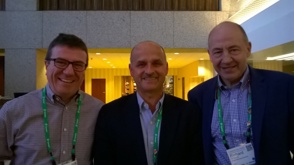
While we in the MN-CMS programme are very proud of our achievements it was both surprising and heartening to meet so many Cerner associates and customers who had heard about MN-CMS and who were interested in talking to the team on how they implemented clinical functionality, the obstacles encountered & overcome, and the lessons learnt. It was absolutely fantastic to get that kind of acknowledgement on a global level.
In recognition of this achievement Cerner invited the MN-CMS programme to present at CHC and we were delighted to do so.
The development of this Nutritional Dashboard is both innovative and first of type, developed and implemented in partnership with NICU Doctors, Nurses, pharmacists, dietitians and Cerner. It provided a real time visual display of the nutritional and fluid intake for infants, to support Enteral and parenteral feeding. These are key components in the provision of care in NICU. Dr Murphy ended his presentation by asking the simple question – Why Change? The answer - two compelling photographs, one a baby in NICU born 15 weeks early, fighting to survive, her father’s wedding ring worn around her wrist; and the second photo: that little baby 12 years on, leaping into the air over a ski jump!
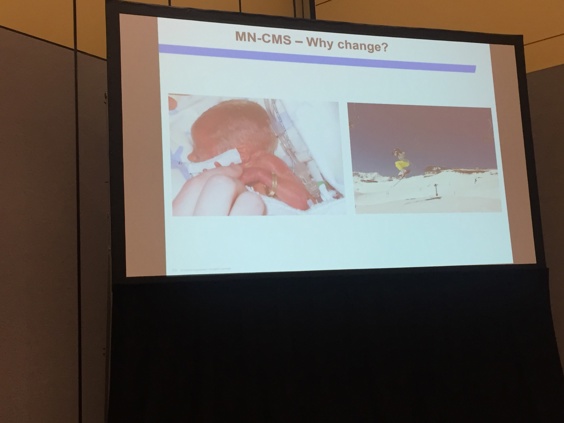
The presentation was exceptionally well received, the reaction from a Neonatologist from Queensland, Australia was that of awe at the achievements, “Wow, we are booking a trip to Cork” (another example of Build it and they will come!).
Prof Richard Greene, Cons Obs/Gynae, CUMH presented on ‘MNCMS – National Solution – Local Deployment’.
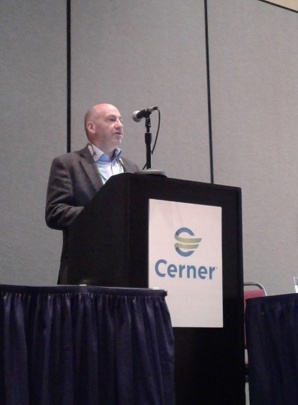
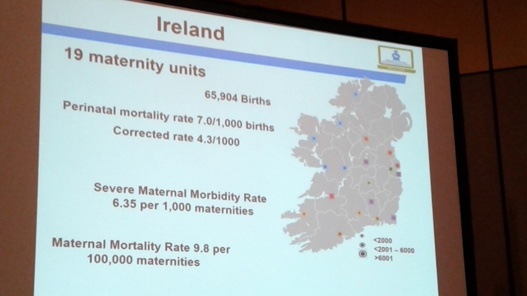
Design Thinking
It is said that good design is obvious, great design is transparent - even invisible. The challenge it presents, is how to introduce great transparent technology, which seamlessly enables clinicians and consistently improves the patients’ experience. Cerner recognise this challenge and have appointed Paul Weaver as VP of User Experience. Great insights into the importance of design, emotional design and improving user experience and adoption where provided by Paul Weaver and his UX team at various educational sessions throughout the conference.
- the women's health group at Cerner including the engineers working on partogram development. They had discussions about the development, outlining the clinical needs and value of proposed changes. Prof. Greene said “It was a very valuable meeting for all and worked well as we were meeting in person. There is a real possibility that this work will be scheduled for CHC2018 to try and encourage uptake of partograms globally”
Other sessions attended:
“Staying current with Soarian upgrade center and CernerWorks”, hosted by Anne McVey, Cerner and Erik Filoon, CernerWorks.
Cerner presented what Upgrade Centre can offer a client – Project Management, Testing, Issue Management & Collaboration between Cerner teams and Client teams. Upgrade Centre Managed Services offers bundled and unlimited upgrades for efficiency. CernerWorks are responsible for Hosting & Infrastructure, Technical Project Management and Value Proposition. On average, Upgrade Centre can save the client 15 days.
The first client speaker was United Health Systems in New York. They have 5 facilities and 896 beds. They spoke of their experiences using Upgrade Centre for Financials & Scheduling upgrades and the value Cerner brought from Project Management, Issue Management and the fact that they really needed them, due to concurrent projects that they were involved in.
Next up, was Northwest Hospital and Medical Centre. This is a full-service, non-profit hospital. HIMSS level 6. 2016 statistics - 281 beds, 10,060 admissions, 2,416 employees, 197,132 clinic visits, 35, 068 emergency department visits and 1,233 births. On their informatics team, they have a Chief Clinical Information Officer, 9 clinical informaticists, ITWorks and 11 IT analysts. They used Upgrade Centre for Clinicals & Pharmacy upgrade. Unit and Release Note Testing was performed by Cerner, but client had to customise the test scripts to their workflows for Cerner. Client still had to perform Integration Testing, Reports Testing & Workflow Testing. They saved 700 hours by purchasing Upgrade Centre. Have purchase UCMS for future projects and spoke very highly of the process.
Next up, was Virginia Department of Behavioural Health. They serve disabled, mentally unwell or substance abuse clients. 14 state facilities and 40 community services. They used Upgrade Centre for Clinicals & Pharmacy upgrade. They had a local Project Manager & a Cerner Project Manager, who collaborated successfully. As a state agency, they felt that they could not do these upgrades without Upgrade Centre and would purchase the service for all future upgrades.
“Essential success: the story of successful big bang implementation”.
The first presentation was from Clara Barton Hospitals & Clinics which is a 23 bed hospital in Kansas with 2,700 patients & 4 clinics. They were migrating from two legacy systems to Cerner, as they had silo’d systems that could not integrate. They had a 10 month implementation, with a large support team. They felt the key points for success were:
- Management Support
- Compliant Client
- Well-staffed implementation team – 54 full time and four medical consultants full time on the project
Next up, was Van Diest Medical Centre. They were also migrating from a legacy system and it took them 8 months to choose Cerner as the vendor. Project implementation timeline was 12 months. 66 people on the team, from a variety of backgrounds. They felt key points for success were:
- Right people
- Plan for turnover
- Document well,
- Keep clinical and financial perspectives in all teams, do not silo
- Testing methodology – use real examples and plan for three rounds
- Communicate
- Tackle early to understand
- Training & Support
- Do not recreate your current world
Day 5 - Wednesday 11th October: - The Main event and Wrap Up
The early morning General Session was entitled “Client value creation”. The speakers were:
- Donald Rucker, MD, National Coordinator, Office of the National Coordinator
- Dan Nigrin, MD, CIO, Boston Children’s Hospital
- William Holland, MD, CMIO, Banner Health
- Zane Burke, Cerner
- Joanne Burns, Cerner
They covered HealtheIntent, and the usage of Open Standards, Open Platforms and Open Source Software. They spoke about the value that clients can utilise from connecting systems, increasing interoperability and ultimately using data analytics on the connected software. Policies must enhance software usage and interoperability and not block the paths.
“Leveraging iCentra to drive care transformation”. The speakers were Vivek Reddy, MD, CMIO, Intermountain Healthcare and Diane Rindlisbacher, RGN, CNIO, Intermountain Healthcare.
Vivek spoke about the journey to digital healthcare and how to transform healthcare. He suggested we have three elements that affect change – Sponsors, Deciders and Education. We need to continually be looking at change, adapt more agile methods and run in 6 week sprints. After each sprint, evaluate, re-calibrate and re-plan continuously. Data analytics can drive and support the areas that really need change. If properly planned, then working fast does not mean failing fast.
Diane spoke about strategy and how important it is. Strategy drives work, which drives structure. Structure enables work, which enables strategy. People need to think differently to drive different results. Different approaches to support adoption – use staff profiles and skills. Support for staff should be pro-active. Supporting staff equals high adoption. Users should never need to call the helpdesk – the support should be monitoring the staff, both on the ground and via data analytics and know who is experiencing problems when. We should be there before they pick up the phone.
“One patient, one record: trials and tribulations of duplicate medical records”. The speakers were Robert Steele, Director Clinical Solutions, Memorial Hermann, Lisa Romero, Application Architect, Memorial Hermann and Paul Cannon, Cerner.
They spoke about the importance of having one complete Enterprise Master Patient Index for all patients. They gave an overview of Memorial Health, 15 hospitals, 158,241 admissions, 595,611 emergency visits, 25, 146 births, 25,000 employees and 4,016 beds. They have Cerner Millennium since 1997, and have 6 registration systems, including Athena, HealthQuest, Lifepoint, EZReg, Home Care Home Base systems. All 6 systems are integrated using CloverLeaf Integration Engine.
To tackle duplicate problems, they introduced HealtheIntent Master Person Management. Uses a probabilistic algorithm to link records coupled with human review. It links the records but does not combine the data. Cerner staff managed the human review element. EMPI with Netrics which manages a patient match queue.
To force the combine in Millennium, pull an extract from HealtheIntent. Import the file to HNA Combine and nightly job combines the records. If records match on 84.4%, then they auto combine. Higher the auto combine rates, the lower the human review queue. Automated merging improved the un-merging rates.
“Digital experiences: elevating care team and patient engagement”. This was a panel discussion, hosted by Paul Weaver of Cerner. The panel were:
- David Chou, VP, Chief Digital Officer, Children's Mercy Hospital
- Susan Collins, Vice President, General Manager Healthcare & Life Sciences
- Prof Peter Knight, Chief Information & Digital Officer, Oxford University Hospitals, NHS Foundation Trust
They spoke about the evolving digital experiences for care teams, patients and even consumers. The path of necessity is stake holder expectations, technology disruption and economic realities. To reach the digital destination, we need to improve relationships with patients, have collaborative working, work efficiently and work intelligently. Challenges are complacency, fear, fixed mindset and technology fatigue.
Peter Knight spoke about Oxford’s digital journey and the planning.
Year 1 – transparent governance, EPR implemented & creation of longitudinal record
Year 2 – 5 – Clinical dashboard, implementation of population records, remote digital services, apps innovation
Year 5 – 10 – AI, CDSS, Applied Research into Practice and personal ownership of healthcare
Patient Portal Demo in the Solutions Gallery. The Cerner demonstration showed us the new Patient Portal, HealtheLife. It is a web portal dashboard, for which access is managed on a personal user registration basis, once enabled by hospital. Self service password re-sets and ability to proxy portal to other users (for children or users unable to manage their own). Proxy access terminated at designated ages or rule based scenario. Portal display is customisable to client requirements, can pull in lab results, radiology results, documentation, allergies, quick links, medications, bi-directional secure communication, appointment viewing, own branding and messaging, etc.
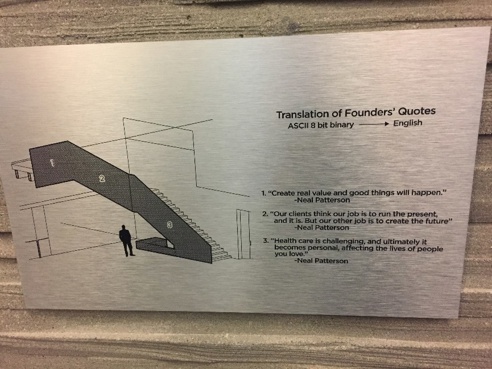
“Healthcare is challenging and ultimately it becomes personal affecting the lives of the people you love”. Neal Patterson – Founder of Cerner
Quotes from the delegation regarding the benefits they have derived from attending:
“Having the opportunity to meet with senior Cerner executives & influencers to share our vision of the future based on the solid experience of having implemented an EHR was invaluable. In addition, I gained valuable learning on how other customers had overcome challenges & optimized their use of the HER”.
Caroline Cahill, MN-CMS Programme Manager, OoCIO.
“The experience of attending CHC was one to remember. The knowledge gained from attending the presentations of other Cerner clients and industry leaders was enlightening and certainly gave me an insight into how other clients utilise the Cerner systems. It also gave me ideas to take home to the Irish implementation, such as the management of duplicate registrations from Memorial Hermann, the upgrade experiences of NorthWest Hospital & Medical Centre and the un-scheduled downtime experience of Queensland Health. It was inspiring to see how other attendees of CHC were impressed by the Irish implementation – the NICU speech by Brendan Murphy really wow’ed the room!!!!”
Deirdre O’Regan, A/NBO Manager | MN-CMS National Back Office
“The benefits I derived from the conference were in seeing the sheer magnitude of options available in relation to CERNER add-on modules & components, and the volume of collaborations CERNER have established with different partners. With the constant evolution of medical technology & the imminent introduction of CERNER millennium into the NMH, a project of this scale will influence decision making of future equipment procurement with one of its main goals having to be ‘integration’. It has also reaffirmed my belief that any hospital hoping to introduce Electronic Health Records will have to have a strong working relationship between Clinical Engineering & Information Technology.”
- Eoghan Hayden, Dept. of Clinical Engineering, The National Maternity Hospital
“For me, there were two categories of benefits.
1) Shorter-term, day-to-day practicalities: Getting a much deeper knowledge and understanding of the people and the roles of the MN-CMS national team, as well as learning from the “warts and all” experiences of counterparts at “Cerner hospitals” outside Ireland
2) Longer term, big picture view: Witnessing a real-world example of a project (the conference), that no matter how complex and ambitious, can run flawlessly if almost unlimited resources are pumped into it, and realising that EPRs will only be one element of the wider “e-health systems” of the future”
- Martin Keane, ICT Manager, National Maternity Hospital
”I felt the conference was a great opportunity to listen to other Cerner clients and see what had worked for them and ofcourse to meet many Cerner staff and tour their new campus to experience and chat about what they achieve and see where they achieve it!”
– Fionnuala Byrne, Data Analyst, National Maternity Hospital
“This has been a wonderful opportunity to see first-hand the successes that have been realised in other countries through the implementation of digital health solutions. It has deepened my knowledge of digital clinical systems and their requirements from an infrastructure perspective, which will be of huge benefit in my role, while also impressing the importance of clinical guidance and collaboration at all stages of an implementation. Meeting and getting to know the eminent clinicians and project teams involved in the rollout of MN-CMS, who I had largely only ever spoken to via phone was really great. And as a bonus, I also have gained a thesis topic for my MSc, and now have the opportunity to research the importance of design thinking in new product development for a clinical system and follow Dr. Robson and Cerner’s progress in the development of a square partogram for MN-CMS.”
– Elaine Naughton, EHR Infrastructure Coordinator, Office of the CIO
“CHC 2017 provided a phenomenal opportunity for learning and collaboration, the concepts encountered and connections forged will be hugely beneficial to the MN-CMS programme. There was a great sense of pride and empowerment having two clinicians from the Ireland MN-CMS Programme, Dr Brendan Murphy and Prof Richard Greene, speaking on this world class, global platform. The sense of pride was further enhanced by seeing the Nutritional Dashboard featured in the Solutions Gallery, as a part of the Cerner Maternity Connected Health Journey presentation entitled ‘Meet Amanda’”.
-Eileen Burke, MN-CMS Senior Project Manager, OoCIO
Related file
- Ambulance Arrivals Project A Case Study
- SNOMED National Release Centre (NRC)
- SVUH Award winning Patient Flow Whiteboard
- Scan for Surgery
- Hospital-based care
- Digital Natives Sign App
- Digitisation of risk assesment tools for Adult mental health services in north Dublin
- Patient Engagement Operating Systems - Hep C
- Digital Transition for HSCPs at St. James's Hospital
- Primary Care Centre Castlebar Case Study
- Mario - Managing active and healthy ageing using caring service robots
- Claimsure - Health Insurance Claims Management System
- Cyber Attack Response
- Data systems in SVUH Emergency Department
- Electronic Discharge Prescription Pilot
- Epilepsy EPR
- eReferral
- eReferral Radiology Pilot
- eRostering
- Electronic Blood Tracking
- GP Practice Management Systems
- Healthmail
- Heart Failure Virtual Clinic
- Infrastructure - MPUP to ECAM
- IT Security - Small changes, big difference
- Kidney Disease Clinical Patient Management System
- Local Asset Mapping Project at St James' Hospital
- LUCY
- Mi Kidney App
- Model Community
- NCHD - Employment Record Portal
- Nursing & Midwifery Quality Care Metrics
- Ophthalmology Electronic Patient Record
- PharmaBuddy
- Radiology & Electronic Patient Record
- National Smart-Pump Drug Library of Paediatric and Neonatal Standardised Concentration Infusions
- Quality & Patient Safety
- Robotic Assisted Surgery Programme
- Shared Learning on EHR
- St. James' Hospital - National Haemophilia System
- Tallaght Hospital Pharmacy
- Tallaght Hospital Patient Engagement App
- Track & Trace
- Using IT to Improve Ireland's Public Sector Healthcare
- National Audiology Clinical Management System (NA-CMS)
- St Vincent's University Hospital Award Winning Whiteboard Patient Flow System
- Snomed Case Study
- Telehealth Project Donegal
- St Vincent's Whiteboard Patient Journey System a Case Study
- Ambulance Arrivals Project

